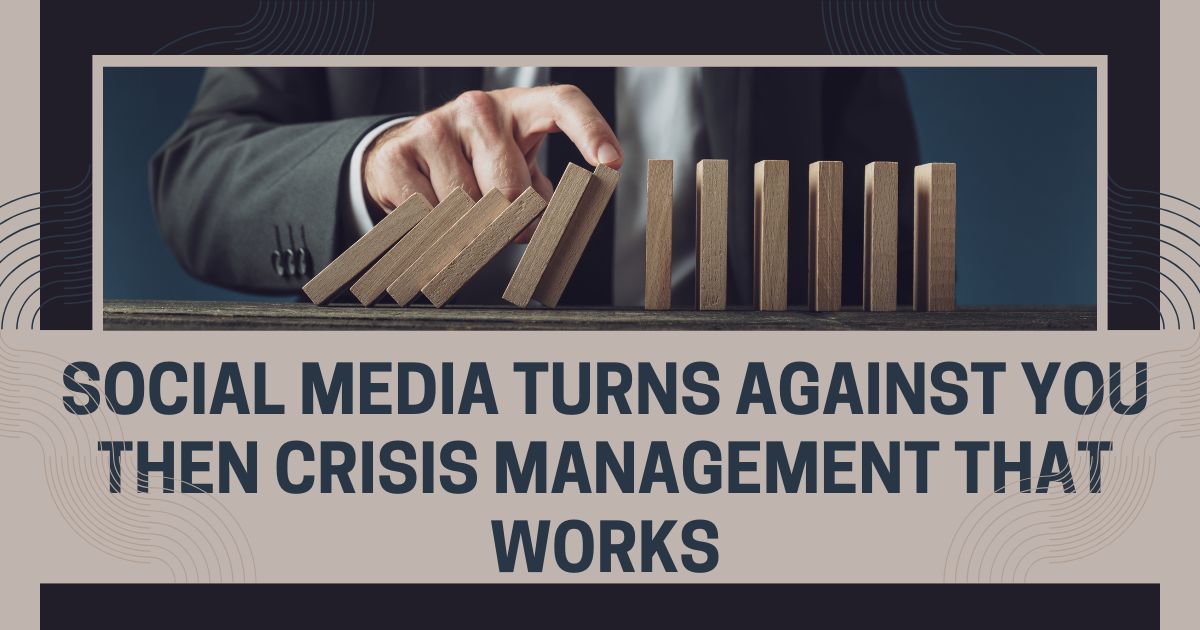
Social media has transformed how brands connect with customers, but it’s also created new vulnerabilities. A single tweet, post, or video can spiral into a full-blown crisis within hours, potentially damaging years of brand building. The question isn’t whether your brand will face social media turbulence—it’s how well you’ll navigate it when it happens.
This guide explores the real impact of social media crises on brands and provides actionable strategies to protect your reputation, maintain customer trust, and emerge stronger from challenging situations.
Understanding Social Media Crises
What Constitutes a Social Media Crisis?
A social media crisis occurs when negative content about your brand spreads rapidly across platforms, threatening your reputation and business operations. These crises can stem from various sources:
- Customer complaints that go viral: A single unsatisfied customer’s post can snowball into widespread criticism
- Employee misconduct: Staff behavior, both online and offline, can reflect poorly on your brand
- Product failures or safety issues: When customers share negative experiences with your products
- Tone-deaf marketing campaigns: Content that misses the mark culturally or socially
- Data breaches or privacy violations: Security incidents that erode customer trust
- Executive missteps: Leadership behavior that contradicts brand values
The Anatomy of Crisis Escalation
Social media crises typically follow a predictable pattern. They begin with an initial trigger—perhaps a customer complaint or controversial post. Without proper response, the issue gains momentum as more users engage, share, and amplify the content.
The crisis reaches its peak when mainstream media picks up the story or when influential figures join the conversation. At this point, the narrative often shifts beyond your control, making damage limitation more challenging.
The Real Cost of Social Media Crises
Financial Impact
The financial consequences of social media crises extend far beyond immediate sales losses. Stock prices can plummet within hours of a crisis breaking. Marketing campaigns may need to be pulled, resulting in wasted advertising spend and lost opportunities.
Customer acquisition costs typically increase as brands must work harder to rebuild trust. Some companies face boycotts that can last months or even years, creating long-term revenue challenges.
Reputation Damage
Brand reputation management, built over years, can suffer severe damage in a matter of hours. Trust scores drop, and customer loyalty weakens. The challenge with reputation damage is its persistence—negative content remains searchable and shareable long after the initial crisis.
Social media crises also affect employee morale and recruitment efforts. Top talent may hesitate to join organizations with tarnished reputations, while existing employees may feel embarrassed or defensive about their workplace.
Operational Disruption
During a crisis, normal business operations often grind to a halt. Customer service teams become overwhelmed with complaints and inquiries. Marketing teams must pause campaigns and redirect resources toward crisis management.
Leadership attention shifts entirely to crisis response, potentially neglecting other important business priorities. This operational disruption can have lasting effects on productivity and growth.
Case Studies: Learning from Real Crises
When Apologies Make Things Worse
Some brands have worsened their crises through poorly crafted responses. Generic apologies that fail to acknowledge specific concerns often backfire. Defensive responses that blame customers or external factors typically amplify negative sentiment.
The key lesson is that authenticity matters more than speed. Rushed responses that haven’t been carefully considered can create new problems rather than solving existing ones.
Success Stories: Brands That Recovered
Conversely, some brands have successfully navigated social media crises by responding quickly, transparently, and empathetically. These companies acknowledged their mistakes, outlined specific steps to address the issues, and followed through on their commitments.
The most successful crisis responses demonstrate genuine understanding of customer concerns and show concrete actions being taken to prevent similar issues in the future.
Building Your Crisis Response Framework
Prevention Strategies
The best crisis management starts before any crisis occurs. Develop comprehensive social media guidelines for employees, including clear expectations for personal social media use. Regular training helps staff understand how their online behavior can impact the brand.
Monitor social media continuously using tools that track brand mentions, sentiment, and emerging issues. Early detection allows for proactive responses before problems escalate.
Create detailed customer service protocols that address how to handle complaints across different platforms. Ensure your team knows when to take conversations private and when to respond publicly.
Response Protocols
When a crisis hits, speed matters, but accuracy matters more. Establish clear escalation procedures so your team knows exactly who to contact and what steps to take. Designate specific individuals responsible for approving public responses.
Develop message templates for common crisis scenarios, but customize them for each specific situation. Cookie-cutter responses often feel inauthentic and can worsen the situation.
The Human Element: Empathy in Crisis Communication
Understanding Your Audience’s Emotions
Social media crises often involve strong emotions—anger, disappointment, fear, or betrayal. Your response must acknowledge these feelings rather than dismiss them. Empathetic communication demonstrates that you understand the impact of the situation on your customers.
Use language that shows genuine concern for those affected. Avoid corporate jargon or legal terminology that can feel cold and disconnected from human experience.
Authentic Leadership Voice
Customers want to hear from real people, not faceless corporations. Having leadership take personal responsibility and communicate directly with affected parties can be powerful. This approach shows accountability and commitment to making things right.
However, ensure that leaders are properly prepared for these communications. Impromptu responses can sometimes create additional problems if not carefully considered.
Platform-Specific Crisis Management
Twitter: The Speed Challenge
Twitter’s fast-paced environment demands quick responses, but also creates opportunities for miscommunication. The character limit forces brevity, which can sometimes lack the nuance needed for complex situations.
Use Twitter threads for longer explanations, but ensure each tweet can stand alone. Consider directing users to longer-form content on other platforms or your website for comprehensive responses.
Facebook: Community Management
Facebook’s comment structure allows for more detailed conversations but also enables prolonged negative discussions. Active moderation is essential, but be transparent about your comment policies to avoid accusations of censorship.
Use Facebook’s features like pinned posts to keep important updates visible, and leverage Facebook Live for real-time, authentic communication during crises.
Instagram: Visual Storytelling
Instagram’s visual nature requires different crisis management approaches. Stories can be effective for timely updates, while posts allow for more permanent statements. Consider how images and videos can support your crisis communication.
Be mindful that Instagram’s younger demographic may respond differently to crisis situations and require tailored messaging approaches.
Legal and Ethical Considerations
When to Involve Legal Counsel
Not every social media crisis requires legal intervention, but some situations demand professional legal guidance. Issues involving product liability, employment law, or regulatory compliance typically need legal review before public responses.
Establish clear protocols for when legal teams should be involved in crisis communications. Balance legal protection with the need for authentic, empathetic responses.
Transparency vs. Privacy
Determine what information you can share publicly while respecting privacy concerns and legal restrictions. Customers appreciate transparency, but you must balance this with protecting sensitive information.
Consider creating general statements about your investigation process or improvement measures without disclosing specific details that could compromise privacy or ongoing investigations.
Recovery and Learning
Post-Crisis Analysis
After managing the immediate crisis, conduct thorough post-mortems to understand what happened and how to improve. Analyze response times, message effectiveness, and overall outcomes.
Gather feedback from customers, employees, and other stakeholders about your crisis management. This input can provide valuable insights for future improvements.
Rebuilding Trust
Trust reconstruction takes time and consistent action. Focus on delivering on promises made during the crisis response. Share updates about improvements and changes implemented as a result of the crisis.
Consider how to turn the crisis into an opportunity for positive change. Some brands have strengthened customer relationships by demonstrating their commitment to improvement through their crisis response.
Technology and Tools for Crisis Management
Monitoring Solutions
Invest in comprehensive social media monitoring tools that provide real-time alerts about brand mentions, sentiment changes, and emerging issues. These tools help identify potential crises before they fully develop.
Set up escalation protocols within these systems so the right people are notified immediately when specific triggers occur.
Response Management Platforms
Use social media management platforms that allow for coordinated responses across multiple channels. These tools help ensure consistent messaging and prevent conflicting communications.
Implement approval workflows that balance speed with accuracy, ensuring important messages are reviewed without creating unnecessary delays.
Preparing Your Team for Crisis Management

Training and Simulation
Regular crisis simulation exercises help teams practice their response protocols in low-pressure situations. These exercises reveal gaps in procedures and build confidence for real crisis situations.
Train teams on empathetic communication techniques and provide examples of effective crisis responses. Role-playing exercises can help staff develop the skills needed for difficult conversations.
Clear Roles and Responsibilities
Define specific roles for crisis situations, including who has authority to make public statements and who handles different aspects of the response. Confusion about responsibilities can slow response times and create inconsistent messaging.
Ensure backup personnel are trained and ready to step in if primary crisis managers are unavailable.
Your Crisis-Ready Brand Strategy
Social media crises are inevitable for brands operating in our connected world. The companies that thrive are those that prepare thoroughly, respond authentically, and learn continuously from their experiences.
Start building your crisis management framework today. Audit your current social media monitoring capabilities, develop response protocols, and train your team. The investment in preparation will pay dividends when you face your next social media challenge.
Remember that every crisis also presents an opportunity to demonstrate your brand’s values and commitment to customers. Handle these situations with empathy, transparency, and accountability, and you may find that your brand emerges stronger than before.



















No Comments